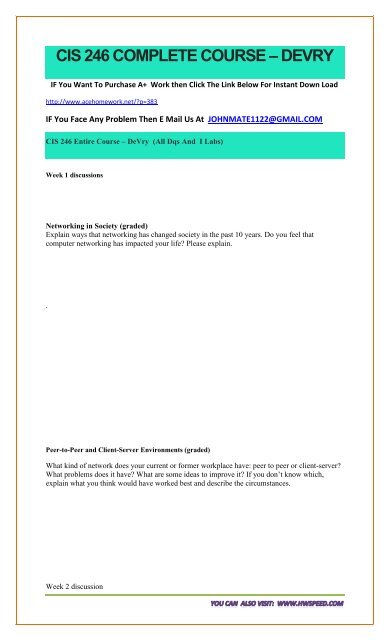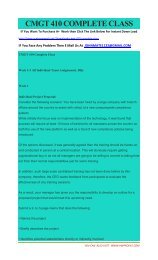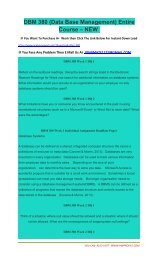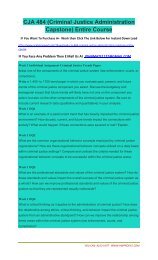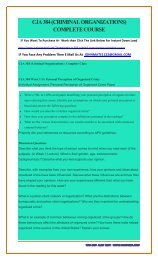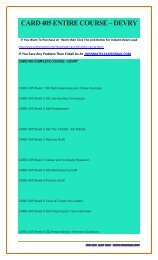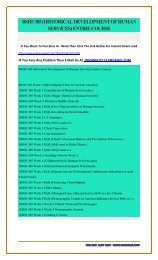CIS 246 COMPLETE COURSE – DEVRY
Create successful ePaper yourself
Turn your PDF publications into a flip-book with our unique Google optimized e-Paper software.
<strong>CIS</strong> <strong>246</strong> <strong>COMPLETE</strong> <strong>COURSE</strong> <strong>–</strong> <strong>DEVRY</strong><br />
IF You Want To Purchase A+ Work then Click The Link Below For Instant Down Load<br />
http://www.acehomework.net/?p=383<br />
IF You Face Any Problem Then E Mail Us At JOHNMATE1122@GMAIL.COM<br />
<strong>CIS</strong> <strong>246</strong> Entire Course <strong>–</strong> DeVry (All Dqs And I Labs)<br />
Week 1 discussions<br />
Networking in Society (graded)<br />
Explain ways that networking has changed society in the past 10 years. Do you feel that<br />
computer networking has impacted your life? Please explain.<br />
.<br />
Peer-to-Peer and Client-Server Environments (graded)<br />
What kind of network does your current or former workplace have: peer to peer or client-server?<br />
What problems does it have? What are some ideas to improve it? If you don’t know which,<br />
explain what you think would have worked best and describe the circumstances.<br />
Week 2 discussion
Transmission Basics (graded)<br />
The lecture covers several standards. Which ones are most common? Which ones are more or<br />
less obsolete? What can you find out about the future of transmission and media types? What is<br />
happening with 10 Gbps? What about 100 Gbps?<br />
Networking Hardware and Topologies (graded)<br />
Let’s figure out what kind of networking equipment an organization would need to buy. You can<br />
make assumptions on size and budget. What do we need to purchase? Why do we need to<br />
purchase it? That is, what will it do for us? How do we hook them together? That is, how do we<br />
cable them (or not cable them) together? Why is there such a big difference in price with the<br />
brands? How do network topologies figure into our selections and designs?<br />
Week 3 discussion<br />
TCP/IP (graded)<br />
There is an alphabet soup of protocols in TCP/IP: HTTP, FTP, SMTP, POP3, TCP, UDP, IP,<br />
ARP, ICMP, and others. What are the characteristics of these protocols? What are they used for?<br />
Has there been an evolution in any of these protocols? Are there any weaknesses or<br />
disadvantages?
Network Servers (graded)<br />
Search the Internet for Windows servers by Dell, IBM, HP, and others. What are the features and<br />
prices? Which ones do you think would be appropriate for the various Windows Server 2008<br />
editions? It is okay not to understand all of the specifications. When you find something you<br />
don’t know, ask the class.<br />
week 4 discussion<br />
Understanding and Applying Active Directory (graded)<br />
Active Directory (AD) is arguably the most critical component of Windows Server 2008,<br />
certainly for larger organizations. It enables corporations to manage and secure their resources<br />
from a single directory service and with a common interface—a very powerful tool. Because it is<br />
so powerful and offers so many features and capabilities, it sometimes can be complex to those<br />
looking at it for the first time. This week, we are going to learn about AD in detail, starting with<br />
the fundamentals. As we progress during the week, you will begin to see it’s not that intimidating<br />
after all. First, though, let’s get the fundamentals down. What exactly is a directory service and<br />
what are some examples in industry? Next, let’s get the definition of Active Directory down—<br />
what exactly is it and what benefits does it provide? After this, we’ll look at the details on how it<br />
is implemented in the business environment.
Linux Versus Windows Administration (graded)<br />
In what ways do you think administering Linux is better than Windows? In what ways is<br />
Windows better than Linux? This can be with regard to having to manage a single server or<br />
multiple servers.<br />
Week 5 discussion<br />
Week 5 discussion<br />
Wireless Networks (graded)<br />
Today, wireless transmission media are commonplace in business as well as residential<br />
applications, and their application is growing. This week, we will learn about wireless<br />
technology by starting with the fundamentals. How are wireless signals carried? What are the<br />
obstacles to successful transmissions and their repercussions? What standards govern wireless<br />
transmissions? How do we secure our wireless networks?<br />
VoIP (graded)<br />
Traditionally, packet-switched networks carried primarily data and the public switched telephone<br />
network (PSTN) carried telephone calls and fax transmissions. Convergence is the use of one<br />
network to carry data, voice, and video communications simultaneously. Let’s begin this<br />
discussion by identifying and discussing key terms such as IP telephony or VoIP, VoATM,<br />
VoDSL, Internet telephony, FoIP, and video over IP.
Week 6 discussion<br />
Network Security (graded)<br />
In this topic please discuss security measures you see in everyday life that you could adopt in a<br />
network environment. You can also include security implementations of places you have<br />
worked.<br />
Network Integrity and Availability (graded)<br />
In this topic, we will discuss measures that can be taken to ensure that a network’s programs,<br />
data, services, devices, and connections are sound and protected from anything that might render<br />
them unusable. What situations can compromise integrity and availability and what, specifically,<br />
can we do to protect our networks?<br />
week 7 discussions<br />
USING A WAN (GRADED)<br />
Find WAN organizations (ISPs) that will connect you to the Internet or connect your offices.<br />
What services do they offer? What costs are involved?
LINUX AND WINDOWS INTEGRATION (GRADED)<br />
What are some ways you could integrate Linux servers into a Windows network to share<br />
information? What would be the advantages and disadvantages? Feel free to get into the details<br />
of Samba, which is covered in the lab. Are there any other products out there? You can get<br />
creative on this one. You could also offer scenarios for FTP, Web, or even Telnet.<br />
Week 1 Lab Report<br />
This document contains the template you will use to complete this assignment. Save the file by<br />
adding your last name to the filename (e.g. <strong>CIS</strong><strong>246</strong>_W1_Lab_Report_EK_Smith.docx).<br />
Follow the steps for this week’s lab. At various points in the instructions, you will be asked to<br />
answer a question or capture a screenshot to document your work <strong>–</strong> type your answers and place<br />
screenshots into this document, then submit this completed Lab Report to the appropriate weekly<br />
Dropbox.<br />
Screenshots<br />
Screenshot of the configuration screen showing the time zone, computer name, and IP address.<br />
(50 points)<br />
Week 2 Lab Report<br />
This document contains the template you will use to complete this assignment. Save the file by<br />
adding your last name to the filename (e.g. <strong>CIS</strong><strong>246</strong>_W2_Lab_Report_EK_Smith.docx).<br />
Follow the steps for this week’s lab. At various points in the instructions, you will be asked to<br />
answer a question or capture a screenshot to document your work <strong>–</strong> type your answers and place<br />
screenshots into this document, then submit this completed Lab Report to the appropriate weekly<br />
Dropbox.<br />
Lab 2a: Install and Configure Active Directory<br />
1. Is the firewall turned on? (3 points)<br />
2. How do you turn off the IE Enhanced Security Configuration.? (3 points)<br />
3. Which link allows you to change the computer name? (3 points)<br />
Screenshots<br />
#1 configuration screen (3 points)<br />
#2 First Diagnostic screen (3 points)<br />
#3 Scroll down to get the rest of the Diagnostics screen (3 points)<br />
#4 Screenshot of telnet command (4 points)<br />
#5 Active Directory installed. Computer name including domain name (4 points)
#6 Windows 7. Computer name including domain name (4 points)<br />
Lab 2b: Organize Users and Groups<br />
Screenshots<br />
#7 Your name logged on to the Windows 7 PC (4 points)<br />
#8. The name of the user in the group (4 points)<br />
#9. Both groups in the middle panel (4 points)<br />
#10. Ability to delete OU (4 points)<br />
#11. Delegated user (4 points)<br />
Week 3 Lab Report<br />
This document contains the template you will use to complete this assignment. Save the file by<br />
adding your last name to the filename (e.g. <strong>CIS</strong><strong>246</strong>_W3_Lab_Report_EK_Smith.docx).<br />
Follow the steps for this week’s lab. At various points in the instructions, you will be asked to<br />
answer a question or capture a screenshot to document your work <strong>–</strong> type your answers and place<br />
screenshots into this document, then submit this completed Lab Report to the appropriate weekly<br />
Dropbox.<br />
Screenshots<br />
#1. Show the permissions for Server Operator<br />
#2. Show the Utilities Properties window<br />
#3. Show the error message<br />
#4. Show your name and show the error message<br />
#5. Show that the drive is R: and the size is 1 KB<br />
#6. Show the November text file with the letter Z: in the text box at the top of the window<br />
Week 4 Lab Report<br />
This document contains the template you will use to complete this assignment. Save the file by<br />
adding your last name to the filename (e.g. <strong>CIS</strong><strong>246</strong>_W4_Lab_Report_EK_Smith.docx).<br />
Follow the steps for this week’s lab. At various points in the instructions, you will be asked to<br />
answer a question or capture a screenshot to document your work <strong>–</strong> type your answers and place
screenshots into this document, then submit this completed Lab Report to the appropriate weekly<br />
Dropbox.<br />
Screenshots<br />
#1. Properties for drive C: (10 points)<br />
#2. chdksk warning (10 points)<br />
#3. Backup destination drive (10 points)<br />
#4. New printer (20 points)<br />
Week 5 Lab Report<br />
This document contains the template you will use to complete this assignment. Save the file by<br />
adding your last name to the filename (e.g. <strong>CIS</strong><strong>246</strong>_W5_Lab_Report_EK_Smith.docx).<br />
Follow the steps for this week’s lab. At various points in the instructions, you will be asked to<br />
answer a question or capture a screenshot to document your work <strong>–</strong> type your answers and place<br />
screenshots into this document, then submit this completed Lab Report to the appropriate weekly<br />
Dropbox.<br />
Screenshots<br />
#1. Ping from Windows 7 based on your name (12 points)<br />
#2. Web Server Role (12 points)<br />
#3. Web page with URL based on your name (13 points)<br />
#4. ipconfig information showing DHCP server and IP address. (13 points)<br />
Week 6 Lab Report<br />
This document contains the template you will use to complete this assignment. Save the file by<br />
adding your last name to the filename (e.g. <strong>CIS</strong><strong>246</strong>_W6_Lab_Report_EK_Smith.docx).<br />
Follow the steps for this week’s lab. At various points in the instructions, you will be asked to<br />
answer a question or capture a screenshot to document your work <strong>–</strong> type your answers and place<br />
screenshots into this document, then submit this completed Lab Report to the appropriate weekly<br />
Dropbox.<br />
Screenshots
25 points<br />
In the space provided below, write a minimum of five college-level sentences in your own<br />
words that describe your experiences with this lab assignment. Include an overview of the<br />
major tasks accomplished in this lab and any difficulties you encountered in the completion<br />
of this lab assignment.<br />
Week 7 Lab Report<br />
This document contains the template you will use to complete this assignment. Save the file by<br />
adding your last name to the filename (e.g. <strong>CIS</strong><strong>246</strong>_W7_Lab_Report_EK_Smith.docx).<br />
Follow the steps for this week’s lab. At various points in the instructions, you will be asked to<br />
answer a question or capture a screenshot to document your work <strong>–</strong> type your answers and place<br />
screenshots into this document, then submit this completed Lab Report to the appropriate weekly<br />
Dropbox.<br />
Screenshots<br />
Task 2Configure the networks file<br />
Step 2: Append network<br />
Clear the screen and use<br />
cat<br />
to display the contents of the /etc/networks file. Capture the Element K desktop in the text box<br />
below.


